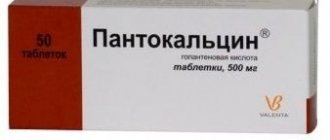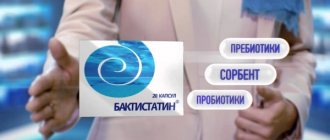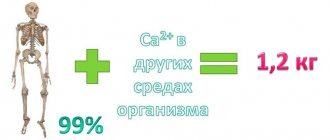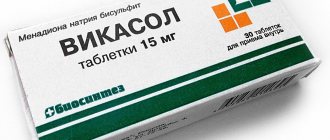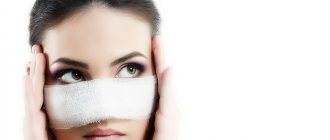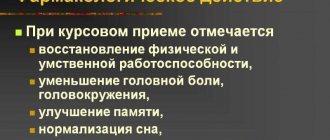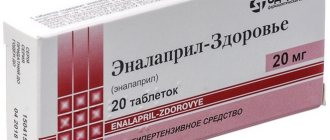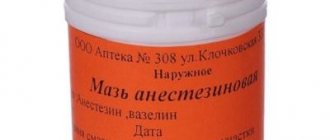Use for PPNS
According to statistics, perinatal lesions of the central nervous system are a common occurrence in infants in recent decades.
From the beginning of the third trimester of pregnancy for the mother until the end of the first week of the baby’s life, there is a possibility that disruptions may occur in the functioning of the child’s nervous system. They may occur due to complicated pregnancy. The fetus may have a history of oxygen deficiency. During the birth process, the newborn may be injured; labor that is too long or too fast can cause underdevelopment of the functions of the nervous system or brain. All these pathologies must be detected within 10 days of birth.
Usually the data is entered into the card upon discharge from the maternity ward, but this is not always enough. The consequences can be identified by a pediatrician during the first examination.
Such disturbances in the functioning of the brain are called perinatal lesions in the nervous system. This can manifest itself in instability of motor functions, speech apparatus and mental state. If, upon examination, a pediatrician finds any signs of such disorders, then this is a direct indication for the use of Pantocalcin.
These symptoms may include:
- Hyper- or hypotonicity (it can be expressed by the inability to relax the limbs or strain them).
- Tremor of the chin or limbs (this means that the child's chin or one of the limbs may tremble slightly during moments of emotional stress).
- The appearance of strong or barely noticeable convulsions (they can appear either as a result of some external influences or without them).
- Immense anxiety or excitability in the child (the baby may cry a lot for no reason, have difficulty falling asleep, wake up several times within an hour).
Pantocalcin for children, reviews of which from pediatricians prove its effectiveness, helps in the treatment of these and similar problems.
Indications for use
Pediatricians often prescribe the drug Pantocalcin; it is suitable for children who suffer from increased excitability; according to reviews from parents, this drug takes a leading position in solving such problems. Children may often wake up at night, their sleep is unstable and short - in these cases, doctors recommend Pantocalcin.
These conditions should not be confused with common sleep disorders in children due to a variety of factors.
We can talk about prescribing Pantocalcin only in cases where sleep is seriously disturbed and all possible causes have been eliminated. Children who have difficulty sleeping at night due to a nervous disorder also have problems during the day. They may suddenly start crying, cannot calm down for a long time, cannot switch attention, and often experience an unreasonable feeling of fear.
If there is a problem with concentration, unstable or slow learning skills, then this tool helps to correct the situation. This also applies to mastering skills at a very early age. These include: reluctance to potty train, slow development of speech or its complete absence at the age of 3 years, constant or periodic stuttering.
In addition, Pantocalcin can be prescribed in tandem with other drugs:
- for epilepsy, developmental delays, both mental and physical, encephalitis and the consequences of skull injuries;
- helps to resolve the problem of spontaneous or night urination, because all these ailments are directly related to the functioning of the brain;
- it successfully fights aggressive behavior in children due to its sedative properties.
Video
In this video, a famous psychotherapist talks about the drug Pantocalcin, its properties, principle and direction of action. Here more detailed information about the drug is revealed and useful tips on its use are given. You can watch the video using the link:
Most mothers are concerned with the question: which drug is suitable for her baby? Pantogam for children in the form of syrup is the most common analogue of Pantocalcin syrup. For those who prefer medicine in tablet form, we recommend Picamilon for children, which has confidently proven itself in the pharmaceutical market. There are good reviews about the drug - Encephabol for children - it is also available in tablets. The solution for injection - Cortexin for children - is produced in ampoules, freezing the substance, transforming it into a powder form for the preparation of further solutions. Today, there are many analogues of this medication and they are available in different forms. The choice is huge, but it's up to you to decide.
Was this article useful and interesting for you? Share your comment. Which is best for you? Write, we will be glad to have your participation in the discussion.
Analogs
Analogues of Pantocalcin are drugs that basically contain calcium hopantene. The most famous of them is “Pantogam”. This syrup is commonly used for the treatment and prevention of disorders in the nervous system in infants.
"Gopantam" belongs to the same group of nootropic substances. It is available in tablets and is used in children for the same indications as Pantocalcin. “Calcium hopanthenate” is another analogue of Pantocalcin. It is based on the same basic substance.
You can replace one medicine with another only with the consent of your doctor.
There are some nuances in prescribing medications; you should especially not self-prescribe medications when it comes to children and their nervous system.
Overdose
Reactions such as nausea or vomiting are rare. This can only happen in case of overdose.
Because the drug is often prescribed to children, adults should be careful to ensure that children are taking the correct dosage. If, through negligence, a child takes more than necessary, he may experience dizziness, decreased blood pressure, and weakness.
Doctors' reviews about the drug
Many parents complain that after starting to take Pantocalcin, the child becomes hysterical and capricious. This may be the body’s reaction to debugging processes in the functioning of nerve cells. This is why the medicine is prescribed in courses so that it has the opportunity to demonstrate a cumulative effect. Therefore, there is no need to fear harm from taking this drug.
Doctors do not find a replacement for this substance, calcium hopatene is necessary for the treatment and prevention of disorders in the nervous system, and Pantocalcin is ideal for these tasks, since it does not have heavy auxiliary substances.
Most often in neurology and pediatrics, this drug is prescribed in combination with others.
Pantocalcin is a medicine that actively works in just such combinations. This is an important quality, since many effective products have many contraindications to combining basic and auxiliary components. Doctors often mention that Pantocalcin has almost no side effects, which is why it is so popular.
According to reviews, “Pantocalcin” is effective in use in children; it copes with many tasks. It is often used in a complex of measures and has a productive effect on the metabolic processes of nerve cells.
Article design: Oleg Lozinsky
At what age is the drug allowed?
Taking Pantocalcin tablets is officially approved for use from the age of three, but many neurologists observing young patients write a prescription for younger children. The reason for this controversy is that the drug itself is harmless and is often used in infants.
But its dosage form in the form of tablets has age restrictions, as indicated in the instructions. Thus, this remedy can be used at any childhood age. The only problem with taking it in infancy is the inability to take pills, but the drug itself has no contraindications.
Manufacturer and release form
In pediatrics, Picamilon tablets are used, which contain GABA in the following dosages:
White tablets are sold in plastic jars of 30 pieces. Instructions are included with the package. Picamilon can be purchased in pharmacies only by presenting a doctor's prescription. Less common on sale are packages of 50 and 100 pieces.
Release form: tablets.
You can buy 30 tablets of 0.02 g for about 80 rubles, and 30 tablets of 0.05 g for 90 rubles.
How much does the medicine cost? Where can I buy?
Pantocalcin tablets are available only with a prescription. Thanks to this, the likelihood of taking medication without a doctor’s recommendation is significantly reduced. The drug belongs to the medium price category. For one package of tablets you will have to pay about 1,500 Russian rubles. The medicine is available in almost every pharmacy. In extreme cases, it can be replaced with an analogue.
You can save money by purchasing tablets online. In online pharmacies the drug costs 100-200 rubles cheaper.
Directions for use, dosage
In each specific case, the doctor individually selects the dosage. It depends on the age of the child, diagnosis and course of the disease.
The table shows standard dosage data from the instructions.
| Child's age | Dosage for urinary disorders | Dosage in the treatment of other diseases |
| 3-10 years | 1 tablet 20 mg 3 times a day | 1 tablet 20 mg 2 times a day |
| 11-15 years | 1 tablet 50 mg 2 times a day | 1 tablet 20 mg 3 times a day |
| Over 15 years old | 1 tablet 50 mg 3 times a day | 1 tablet 20 mg 3 times a day |
It is allowed to give Picamilon to a child both before and after meals. The tablets should be swallowed without chewing and washed down with water. You can offer your child to take the tablet with milk, compote or other liquid instead of water. This will not affect the absorption of the drug.
The tablets can be taken with milk.
The duration of use of the medicine is usually 1-1.5 months. If necessary, the doctor may prescribe a second course of treatment, but not earlier than 3 months after the end of the first.
Review from Tatiana, mother of 4-year-old Andrey:
Should Pantocalcin be given to children? Reviews. Price
When a doctor prescribes this medication to a child, parents are usually scared. Many people think that this medicine is prescribed only to mentally retarded children. It is especially scary, according to mothers, to give the drug to infants. “This remedy will not cause harm,” they fear. Experienced parents reassure doubting mothers and fathers and write in their reviews that the drug “Pantocalcin” is not as scary as it is painted, and, on the contrary, has greatly helped their children become smarter and more attentive, cope with stuttering and other disorders. Parents of infants say that after treatment with Pantocalcin, their babies began to sleep more peacefully.
There are also negative reviews. Thus, some mothers write that their children became even more agitated and distracted during treatment with the drug. But there are very few such statements, and they are lost in the huge number of positive opinions. Therefore, you should not be afraid to give the medicine “Pantocalcin” to children. The price of the medicine for a package of tablets (50 pieces) containing 250 milligrams of calcium hopantenate is on average 202-219 rubles, 500 milligrams of calcium hopantenate - 320-350 rubles.
Treatment regimen for night pathology
Drugs for the treatment of nocturnal diuresis are as follows:
- Minirin is a Swedish-made tablet drug. It contains desmopressin. Indicated for use in children over 5 years of age with primary enuresis. This reduces the number of urges to urinate.
- Pantogam - tablets are prescribed to children from 2 years of age for bedwetting and imperative enuresis. This drug is indicated for the treatment of incontinence against the background of seizures and severe motor excitability. It has a mild sedative effect and stabilizes the functioning of neurons in the cerebral cortex. It is not recommended to use this drug in the first trimester of pregnancy, in case of kidney pathology and individual intolerance to the components of the drug.
- Melipramine - used from 2 years. This is a Hungarian drug for neurogenic enuresis. The active ingredient is imipramine. Available in tablet form. This antidepressant has a general strengthening, stimulating, antioxidant effect. It can often provoke convulsions, insomnia, arrhythmias, allergic reactions on the skin, excess weight, and baldness. It cannot be used for acute pathologies of the liver and kidneys, decompensated diabetes mellitus, tuberculosis, lactation, prostatitis, and the first trimester of pregnancy. Melipramine is often used to treat enuresis associated with mental pathologies. It is safely prescribed for the treatment of adult enuresis.
Is it possible to take Pantocalcin with alcohol?
Home / Is it possible? / Is it possible to take pantocalcin with alcohol?
Modern nootropic drugs are powerful drugs that have a beneficial effect on processes occurring in the brain. They are often used both to treat various diseases of the central nervous system, and simply to prevent and improve brain function. In addition, they significantly increase the endurance of neurons and their resistance to various negative influences. Increased concentration, high mental stress, consumption of strong drinks - all this has a detrimental effect on brain cells, gradually destroying them. In order to prevent this process, restore the functionality of neurons and improve mental processes in the brain, the highly effective drug Pantogam is used. Is it possible to take Pantogam and alcohol at the same time? Will such compatibility entail unexpected consequences? The interaction of alcoholic beverages and a drug is directly related to its medicinal properties, the presence of side effects and contraindications. Therefore, to begin with, it is worth understanding how Pantogam will behave once it enters the human body, what its action is aimed at, and what consequences its combination with other medications will lead to.
The drug contains hopantenic acid, which has a powerful nootropic effect. It helps improve memory and mental activity, normalizes metabolic processes in the body, and provides oxygen access to the brain. At the same time, its effective anticonvulsant and hypotensive properties are known.
In the presence of such an active substance as hopantenic acid, Pantogam helps relieve pain, improves mental activity and performance. This medication is often prescribed to patients with cerebral insufficiency and hyperkinetic disorders. It is also effective for neuroleptic syndrome, as well as for parkinsonism, clonic stuttering in children and Jacksonian epilepsy.
It is also worth noting the extremely low toxicity of the drug and its ability to prolong the effect of barbiturates.
At the moment, there is a modern and improved version of Pantogam - Pantogam active, which has a more pronounced anticonvulsant effect and nootropic properties than the first generation drugs of hopantenic acid.
Indications for use of the drug are:
- childhood mental disability;
- epilepsy, both as a stand-alone drug and as part of complex therapy;
- oligophrenia;
- speech and developmental delay in children;
- pain relief, especially with trigeminal neuralgia;
- traumatic brain injuries;
- infectious diseases of the central nervous system;
- decline in mental abilities;
- schizophrenia.
This medication is available in syrup and tablet form. The syrup is mainly used to treat children.
Pantogam should be stored at room temperature in a dry, dark place away from children.
The dosage of the drug and the duration of treatment are directly dependent on the patient’s age and the individual characteristics of his body. And also on the severity of the disease and its variety. The medication must be prescribed by the attending physician and used under his supervision.
Tablets are taken approximately half an hour after meals. The duration of treatment takes one to four months. A repeat course can be taken three months or six months after the end of the initial treatment. The daily dose for children is from 0.75 grams to 3 grams, for adults – from one and a half to three grams.
For mental retardation, children are recommended to take 0.5 grams of the drug four to six times a day.
For epileptic seizures, adults are prescribed from 0.5 to 1 gram of Pantogam three to four times a day; for children, 0.25 to 0.5 grams are prescribed three to six times a day.
It is also worth noting that the medication significantly increases the effect of antiepileptic drugs. And also with its help you can reduce the possibility of side effects from the use of antipsychotics. When combined with glycine, the effect of Pantogam increases.
Taking the drug is contraindicated if:
- lactation and pregnancy;
- renal failure;
- individual intolerance to the components included in its composition;
- allergic manifestations.
Although the drug is low-toxic, it can cause various negative reactions in the body associated with its use. These usually include various types of allergies:
- skin rash;
- rhinitis;
- inflammation of the mucous membrane of the eyes and nose;
- conjunctivitis;
- redness of the skin.
At the first appearance of alarming symptoms, you should immediately stop taking the medicine, rinse your stomach, and also take activated carbon or other adsorbents. It is also necessary to urgently consult a doctor about replacing the drug with an analogue or adjusting the doses of Pantogam.
This medicine is often used to get rid of a hangover. How effective is it and how long after can you take the medicine after drinking alcohol?
This medicine really helps with a hangover. However, in order to relieve unpleasant symptoms, one tablet taken directly in the morning at the most difficult moment is enough.
If you use this medicine constantly, you can cause irreparable damage to your health.
It is known that with an overdose of Pantogam, reactions occur in the form of severe pain, as well as heaviness in the head and discomfort in the joints.
And the use of alcohol simultaneously with this drug contributes to the concentration of the active substance in the body, which leads to an overdose of the drug.
Many people believe that since a medicine helps with a hangover, it will also actively help prevent it. However, this is not the case. And taking the drug while drinking alcohol is strictly prohibited, as is its use in case of severe alcohol intoxication.
Ethanol enhances the side effects caused by the action of the medication on the body, which, in addition to allergic reactions, include:
- sleep disorders and insomnia;
- weakness and increased drowsiness;
- decreased performance and increased fatigue;
- general malaise;
- noise and ringing in the ears.
When taking medication simultaneously with alcohol, it is strictly forbidden to perform work that requires increased concentration, get behind the wheel of a car, or operate complex machines and mechanisms.
If there are severe signs of ethanol poisoning, you should stop using Pantogam and not take it for a couple of days after drinking strong drinks.
It is not recommended for adults to use the drug in syrup form to get rid of a severe hangover. The fact is that in its composition, in addition to the active ingredient, it contains sodium benzoate, which negatively affects the body during withdrawal symptoms. In this form, Pantogam can be used with a slight hangover or when a person is not prone to alcohol abuse.
It is best to take the medication three to five hours after drinking alcohol. In this embodiment, the drug has the most effective effect on the human body and helps to quickly deal with the consequences of the harmful effects of ethanol toxins.
You are allowed to drink alcohol again approximately twelve hours after taking the Pantogam tablet. During this time, all components of the drug will be eliminated from the body.
Pantogam is a modern nootropic drug, widely used in medicine to improve brain function and normalize the processes of the central nervous system. In addition, it helps to increase physical performance and mental activity, helps improve memory and concentration. The simultaneous use of this medicine and strong drinks is strictly contraindicated due to the negative damage that can be caused to the body. Such an interaction will significantly increase the adverse reactions from taking the drug, and may also contribute to its maximum concentration in the body, and therefore an overdose. In case of severe withdrawal syndrome in the case of chronic binge alcoholism, the use of Pantogam is prohibited, however, it is quite effective in mild stages of a hangover with rare consumption of alcoholic beverages.
source
The property of hopantenic acid to influence functional changes in brain activity prompted scientists to create the drug Pantogam. This powerful remedy can restore brain function in cases of heavy overload and in situations of alcohol intoxication. The admissibility of taking medication together with alcoholic beverages in this matter remains open.
Pantogam belongs to the class of nootropic drugs. The main task is a positive effect on brain cells, increasing their resistance to toxic influences from the outside. The ability of the medication to influence pain, along with a calming effect, is of no small importance during psycho-emotional stress, and reduces tone during heavy physical overload.
The drug has a moderate anticonvulsant effect, acting on extrapyramidal syndromes underlying damage to the subcortical nodes of the central nervous system.
The presence of hopantenic acid in the active ingredient helps eliminate the effects of hangover syndrome and stimulates the restoration of neurons lost due to intoxication.
The presence of gamma-aminobutyric acids in the molecular composition of the medicinal prescription affects anabolic disorders of the body, which, in turn, normalizes fluctuations in blood glucose levels.
The effect of GAM acids on improving cerebral blood supply and increasing stable resistance to hypoxia was also discovered. Thus, Pantogam combines the functions of a nootropic, a tranquilizer and a sedative.
Medicines are sold in pharmacies in two forms:
- syrup of white or pale yellow color, with a slight cherry smell, volume 100 ml in a bottle;
- hard white tablets with the active ingredient composition of 250 and 500 mg, quantity of 50 pills per package.
Any medical product in the treatment of any disease has side effects on other organs and can intensify the concomitant disease. The work of Pantogam in combination with other medications eliminates the negative effects and enhances the therapeutic activity of the latter.
Based on feedback from pharmacists, the joint use of local anesthetic substances increases the prolonging effect of anesthetics. When taken in parallel with sleeping pills and sedatives, it prolongs their executive functions and enhances the therapeutic effect of anticonvulsants.
Blocks accessory changes of neuroleptics, progresses in complex therapy with Glycine tablets.
Similar drugs with the resulting active substance have a similar effect. These include:
- Pantocalcin;
- Gopantam;
- Hopantenic acid;
- Phenibut;
- Encephabol.
Therefore, if Pantogam is not available, the pharmacy pharmacist can offer a medicine with a similar effect.
Rarely, Pantogam causes allergic reflexes. They are expressed by tinnitus, lacrimation, urticaria, and diathesis rashes. In very rare cases, neurological disorders may be activated: drowsiness or insomnia, increased excitability.
Such phenomena do not last long, but in such cases it is recommended to reduce the dose of the medication and be sure to inform your doctor.
Despite the many positive dynamics of taking the medication, it is not recommended for patients with chronic kidney disease, pregnant and lactating women.
Alcohol causes particularly fundamental harm to the body. Ethanol causes negative effects on the cardiovascular and gastrointestinal systems. Increases pain, nausea, disrupts the normalization of blood sugar, promotes the death of red blood cells - blood cells that carry oxygen through tissues. It is because of this that a drunk person loses his balance point, his headache worsens, and convulsions appear.
When drinking too much alcohol, an attack of alcohol intoxication occurs, which leads to a severe hangover.
The use of Pantogam helps to improve the passage of intoxication due to the action of hopantenic acid.
- restores vigor;
- reduces headaches;
- optimizes brain function;
- restores performance.
The best time to take the medication is in the morning, 30 minutes after eating. Nominal dose required to relieve symptoms: 4 tablets of 500 mg.
Gently acting on the body's neuroleptic systems, the product restores electrolyte balance and relieves alcohol syndrome. A proven nootropic - a fast-acting, time-tested, trouble-free medicine.
However, you should not think that Pantogam cures hangover addiction and is used in direct compatibility with ethyl products. The use of Pantogam and alcohol against the background of constant drinking leads to a severe form of poisoning, entailing unpredictable consequences.
When Pantogam and alcohol are taken together, as well as when the medication is regularly used to relieve symptoms, the medicine intended to help turns into poison.
The simultaneous use of the drug and alcohol increases the dosage of the active substance hopantenic acid, which leads to an overdose, causing irreparable harm to health. This combination increases the side effects:
- general weakness;
- aches, joint pain;
- increased irritability;
- lack of coordination;
- sleep dysfunction.
It is strictly prohibited to take medication and alcohol together during work that requires increased concentration. The use of Pantogam is excluded in cases of chronic binge drinking and severe withdrawal symptoms.
Give the medicine with extreme caution when using other forms of nootropic drugs against the background of a hangover.
In case of intoxication with ethyl alcohol together with Pantogam, you must:
- Give the patient a large amount of boiled water to drink.
- Rinse the stomach by inducing vomiting (the patient should lie on his side).
- Prescribe activated carbon tablets (1 tablet per 1 kg of weight).
- If the condition worsens, call an ambulance.
source
March 26, 2021 admin 533
Therapy methods
There are different pills for enuresis. Antidiuretic hormone of synthetic origin - Desmopressin, Adiorekin SD. This type of medicine replenishes the hormone vasopressin, which reduces the accumulation of urine at night. The medications contain a synthetic analogue of desmopressin, which has a pronounced effect on the kidneys.
Desmopressin tablets are available under the name Minirin or in spray form. The use of such drugs is recommended after 6 years for a duration of 3 months. Tablets are used once. The most common side effects: pain in the head, stomach, increased sweating. The development of water intoxication resulting from the accumulation of water is often observed.
In this case, nausea, vomiting, and convulsions develop. To prevent the occurrence of such symptoms, you should adhere to dosages and control your drinking regime. 2 hours before bedtime, you should not give your child anything to drink, and control the amount of liquid you drink per day. It is through control that the development of complications can be prevented. The drugs are effective, although almost every second patient experiences a relapse of the disease after stopping them.
Anticholinergic medications are as follows:
- Atropine;
- Belladonna (Demoiselle);
- Levzin;
- Detrol;
- Driptan;
- Spasmex;
- Detrusitol.
Medicines affect smooth muscle organs. Therefore, the bladder has the ability to increase in size. Drugs in this group act on the sphincter apparatus, enhancing the ability to retain urine. Modern drugs Driptan, Spazmex, Detrusitol act selectively on the urinary muscles, reducing the systemic effect of such medications.
The development of side effects in the form of dry mucous membranes, abdominal pain, and vision problems is observed. They significantly reduce the formation of sweat, so they are not recommended for fever, increased body temperature, and are rarely prescribed during sports or dancing and in hot weather.
An overdose is characterized by anxiety, agitation, possible psychosis, a drop in blood pressure, pale skin, and the development of coma. These drugs are indicated for the neurogenic type of enuresis (hyperreflex type). When used correctly they are absolutely safe.
What is enuresis?
Urinary incontinence in a child occurs:
- primary (persistent);
- secondary (recurrent).
1 is when the patient is five years old and has not previously recorded a single “dry period” lasting more than six months.
2 is when nocturnal enuresis in children occurs after a “dry period” lasting several months or even years. A recurrent disease is usually associated with a concomitant course of urological, endocrinological, neurological or mental disorders of the body.
Nocturnal enuresis
In addition, enuresis occurs:
- night (85% of patients);
- daytime (5%);
- mixed(10%)
The presence of daytime and mixed types of illness indicates the presence of neurological and emotional problems.
The presence or absence of concomitant pathologies classifies enuresis as follows:
- uncomplicated;
- complicated at night (urinary tract infection, pathological change in the structure of the genitourinary system, as well as the neurological condition of the patient).
Based on this classification, it is impossible to clearly identify the main points, so many studies indicate the need to introduce more detailed terminology.
The neurotic course of the disease is typical for a fearful, shy patient who is very worried about any life situations.
With a neurosis-like course of the disease, the patient is more indifferent to what is happening around him.
Many experts give credit to monosympathetic nocturnal enuresis, which is characterized by bladder dysfunction and impaired awakening.
How does the drug affect the body?
The calcium salt of hopantenic acid has a direct effect on GABA beta receptors. In addition, the drug affects the neurotransmitters of the serotonin, dopamine and norepinephrine systems.
According to research results, the active substance of the drug “Pantocalcin” normalizes glucose metabolic processes in the body, in particular, improves the digestibility of sugar in brain cells. This has a positive effect on the functioning of the cerebellum, hypothalamus, subcortical ganglia and cortex.
In addition, this substance normalizes the exchange of nucleic acids in nerve tissues, stimulates anabolic processes, and improves oxygen supply to cells. Like most nootropic drugs, Pantocalcin has a positive effect on memory and the ability to concentrate, and facilitates intellectual work. Along with this, the drug has mild sedative properties, which helps fight pathological hyperactivity.
The medicine also increases detrusor tone and enhances the vesical effect, which helps normalize the processes of urine excretion from the body. The drug is also used in the treatment of chronic alcoholism - the tablets help alleviate the patient’s condition after giving up alcohol.
Interaction
Pantocalcin for children, reviews of which are only positive, works great in tandem or in a broader combination with other medications. It is safe to say that this drug in some cases stimulates the action of other components.
It significantly increases the duration of the work of barbiturates and increases the direction of action of other drugs on the nervous system. In addition, it may reduce the harmful effects of phenobarbital. The base substance of Pantocalcin, calcium hyponate, acts many times more powerfully together with glycine.
Pharmacodynamics and pharmacokinetics
Pantocalcin for children, reviews of which are positive, is prescribed for hyperactive behavior common among adolescents and preschoolers. It inhibits the processes of excitation of the nervous system, providing a mild sedative effect. By acting on areas of the cerebral cortex, it can help improve memory and rapid memorization processes.
The ability to assimilate educational material increases significantly with systematic use of this medicine. This happens because the nerve cells begin to work correctly and fully.
When taken orally, the substance is quickly absorbed from the gastrointestinal tract, the maximum concentration is reached within one hour. The main sedimentation of the product occurs in the liver and kidneys. 48 hours is the maximum rate of excretion from the body, which is carried out unchanged.
How to cure enuresis
Answer the question unambiguously: How to treat enuresis? This is not possible, since it requires a multifaceted approach. Once a diagnosis is made, the work of one specialist is not effective. Only a group of doctors, which includes a pediatrician, pediatric urologist, nephrologist, psychologist, and other specialists, as necessary, are able to determine the most effective treatment method.
Picamilon for enuresis
Complex treatment includes the use of tablets, folk remedies, and massage.
An effective cure for enuresis is Picamilon. It represents a group of nootropics, the action of the active substances of which is aimed at stimulating brain functions, having a vasoactive, noo- and vegetotropic effect.
What does it mean? Picamilon eliminates sleep problems by providing a calming effect. Urinary incontinence in children should also be treated with acupressure, characterized by certain tactics.
The process is useful in that the patient’s metabolism is normalized and the functioning of the main organs improves. Therapeutic massage should be done twice every day.
Important! The effect of amateur massage for enuresis in children is practically zero, so a qualified specialist is simply necessary.
Many parents ask: How is enuresis treated in boys or girls? There is no significant difference between the gender of the child. The main thing is that the technique is effective. Psychotherapeutic procedures are also necessary, since only a specialist can understand the cause of children's internal experiences.
Under no circumstances should you reproach, shame, or even beat a child if he wets himself. It will only get worse! Psychological support from loved ones is very important on the path to recovery.
How to treat childhood enuresis
Treatment of incontinence also includes a set of preventive procedures after recovery, or to prevent it. The rules are simple and clear:
- drinking regime;
- less fluids in the evening;
- healthy emotional family climate;
- regular and complete emptying of the bladder;
- potty training.
Pantogam and alcohol: compatibility, reviews
The opinions of patients and their relatives about the combined use of Pantogam with alcohol are varied. Some people believe that the medicine does not bring any particular benefit and does not alleviate the symptoms of a hangover. Others point to the positive effect of Pantogam in alcohol intoxication. However, most people agree that simultaneous use of Pantogam with alcoholic beverages contributes to the occurrence of adverse reactions.
“When my husband drinks, I always try to give him some pills in the morning to help him recover faster. Pantogam wasn't much use. Maybe he helps, if you drink too much once, but my husband is “experienced” and doesn’t take anything from him.”
“It so happened that the Pantogam course was scheduled just in time for the New Year holidays. Of course, I didn’t overdo it, but I did drink a couple of glasses of champagne during the evening. I felt fine, but I just wanted to sleep early.”
Prevention
Prevention is the main way to avoid disease. To prevent enuresis in children, measures such as:
- timely training of the child to use the potty;
- compliance with the drinking regime;
- avoiding fluid intake before bedtime;
- control over the regularity and completeness of bladder emptying;
- maintaining the emotional climate in the family.
Effective prevention is the key to a child’s health. It is important to note that the more attentive and caring parents are towards their child, the greater the chance of a favorable outcome.
Enuresis is a disease characterized primarily by the main symptom: uncontrolled urination. The age of children with nocturnal enuresis usually corresponds to the preschool or early school period, when bladder activity becomes controlled.
Compound
The developers took nicotinoyl gamma-aminobutyric acid as the basis for the composition.
In order for the chemical compound to be better absorbed by the body, it was supplemented with:
- starch (potato and corn);
- magnesium hydroxycarbonate;
- calcium stearate;
- sucrose;
- talcum powder
In the injection solution, this substance is contained in a dose of 100 mg in each ampoule (50 mg in 1 ml), and in one tablet its amount can be either 20 or 50 mg.
Additionally, the solid form of Picamilon contains calcium stearate, corn and potato starch, sodium carbonate, talc and sucrose. In ampoules, sterile water and hydrochloric acid are added to the active substance.
General information about Pantocalcin
the drug is actively used in the neurological and psychiatric fields of medicine and is a relatively safe drug among a number of similar ones, therefore it is often prescribed to children.
Drug group: nootropic and mental stimulants. International nonproprietary name (INN): Calcii gopantenat.
Forms of release and price of the drug
This drug is produced in the form of small, uncoated tablets. Tablets are packaged in 50 pieces in a plastic or glass bottle, as well as in blisters of 10 pieces, 5 blisters per box. The average prices of the drug and its main generics are presented in the table.
| A drug | Price |
| Pantocalcin, 250 mg | 430-530 rub. |
| Gopantam, 250 mg | 250-340 rub. |
| Calcium hopantenate, 250 mg | 250-320 rub. |
| Pantogam, 250 mg | 410-520 rub. |
Composition and pharmacological properties
One tablet of the drug contains 250 mg of calcium hopantenate. Excipients: talc, potato starch.
The main active ingredient of the drug, calcium hopantenate, is a representative of the group of nootropics. This substance is a derivative of hopantenic acid, which forms the basis of a number of nootropic drugs. The pharmacological effect of this medication is due to the stimulating effect of calcium hopantenate on the gamma-aminobutyric acid (GABA) system. The GABA system, increasing its effect, inhibits the neurons of the central nervous system, due to which metabolism and many functions of nerve cells are normalized.
Characteristics of the drug
In addition, stimulation of the GABA system gives a weak sedative and calming effect, has a moderate stimulating effect, enhances concentration, and also restores GABA content in chronic alcohol intoxication.
When taken orally, the drug is quickly absorbed into the blood from the gastrointestinal tract. The active substance is able to penetrate the blood-brain barrier, which determines its effect on brain neurons. The active components of the drug are concentrated in the nervous tissue, in the cells of the liver, kidneys and skin.
Mechanism of action
The drug is not metabolized in the liver, which makes it possible to use it in liver failure. It is excreted unchanged, mainly in urine, and in small amounts in feces.
See also:
Hopanthenic acid - instructions for use and what is it?
Price in pharmacies in Moscow, St. Petersburg, regions
Prices for the drug according to a large pharmacy chain in Russia:
| City | Price for 250 mg | Price for 500 mg |
| Moscow | 390 rub. | 625 rub. |
| Saint Petersburg | 389 rub. | 634 rub. |
| Krasnoyarsk | 385 rub. | 662 rub. |
| Krasnodar | 502 rub. | 704 rub. |
Pantocalcin for children, reviews of which encourage more frequent prescription of the drug, has approximately the same prices across the country.
In what cases is Picamilon used for children?
Medicines containing GABA are not recommended for use in children under 3 years of age.
Picamilon is known to pediatricians as an effective and relatively safe remedy. Your pediatrician may prescribe this medicine in the following cases:
- with delayed psychomotor development;
- with delayed speech development (SDD);
- under intense loads;
- with attention deficit disorder;
- for urinary disorders, enuresis;
The drug will help with urinary incontinence.
- during the recovery period after a head injury.
Do not give Picamilon to children to stimulate general development unless there is an indication for taking the drug and it has not been prescribed by a doctor. Uncontrolled use of nootropic drugs can harm the baby's developing brain.
Review from Natalia, mother of 7-year-old Vika:
The medicine increases the ability to concentrate.
Use for hyperactivity syndrome
It is customary to call some states of excitability in children hyperactivity. In fact, the term is used with a different meaning among medical professionals. The diagnosis sounds like attention deficit hyperactivity disorder or ADHD. According to statistics, 15 percent of children of preschool and primary school age are diagnosed with it.
The external manifestations of this disease are pronounced disruptions in behavior and attention; upon a detailed examination of the brain, specialists discover characteristic signs of abnormalities in the cerebellum. The use of Pantocalcin leads to a decrease in excessive excitability and the appearance of directed concentration of attention during learning.
Pantocalcin for children is used for hyperactivity syndrome.
For children who suffer from attention deficit, a skill such as perseverance is important. Thanks to the action of the drug, it becomes possible to teach such children. Many parents often make their own conclusions about their children’s hyperactivity; this should not be done. Only a specialist can make a diagnosis; it is not based on the child’s bad and excessively noisy behavior.
To make such a diagnosis, serious examinations are required. Children are often inattentive and overactive, but attention deficit is a medical term and should not be confused with normal, albeit loud, behavior.
Pharmacology
Picamilon is used in medicine as a psychostimulant, nootropic agent.
Thanks to the properties of the active substance, the following effects are achieved:
- antioxidant;
- antiaggregation;
- antimigraine;
- nootropic.
When it enters the systemic bloodstream, cerebral circulation significantly improves, memory improves, and a clearer concentration of attention appears. The active component has a beneficial effect on the vascular system and activates mental activity.
The medicine is also used as a tranquilizer.
The course of treatment helps to stabilize the psycho-emotional background, eliminate insomnia and irritability.
Overdose and interaction with other drugs
Confirmation of an overdose is clearly expressed side effects from the central nervous system. If such symptoms are observed, you should perform gastric lavage and drink an adsorbent.
The medication enhances the effects of drugs that stimulate the nervous system. Prescribed in combination with medications aimed at working with the central nervous system. By interacting with anti-convulsants and barbiturates, the risks of side effects are reduced and the effectiveness of treatment is increased. The negative impact of neuroleptics is removed after a course of therapy. In complex treatment with Glycine, it enhances the effect of the drug.
Contraindications and side effects
Pediatricians and parents rarely note the negative effects of the drug. Sometimes a patient may experience the following symptoms when taking Picamilon:
- allergic reaction to the skin in the form of a rash;
- headache;
One of the side effects is headache.
- feeling of anxiety, irritability;
- nausea;
- dizziness;
- decreased blood pressure;
- redness of the face due to a rush of blood.
If one or more symptoms appear in a child, you should contact your pediatrician. The doctor will determine how much to reduce the dosage so that side effects do not occur or prescribe another medicine.
The medicine is not recommended to be taken if you have:
- renal failure;
- kidney diseases;
- hypersensitivity to any of the components of the product.
The drug is not intended for children under 3 years of age, unless the potential benefit to the child outweighs the possible negative effect on the body.
pharmachologic effect
Nootropic drug. The spectrum of action is associated with the presence of GABA in the structure. The mechanism of action is due to the direct effect of pantocalcin on the GABAB receptor-channel complex. It has neurometabolic, neuroprotective and neurotrophic properties.
Increases the brain's resistance to hypoxia and the effects of toxic substances, stimulates anabolic processes in neurons.
It has an anticonvulsant effect, reduces motor excitability while regulating behavior. Increases mental and physical performance. Helps normalize GABA content during chronic alcohol intoxication and subsequent ethanol withdrawal. Shows analgesic effect.
The drug is able to inhibit acetylation reactions involved in the mechanisms of inactivation of procaine (novocaine) and sulfonamides, thereby prolonging the action of the latter.
Causes inhibition of the pathologically increased bladder reflex and detrusor tone.
Treatment
Attention! The process of urination is definitely fully formed upon reaching the age of four, so the disease is not diagnosed in younger children. Treatment for urinary incontinence begins at the age of four years or older.
Features of the disease in girls
Treatment of enuresis in girls is a little simpler.
This is due to the fact that the functioning of their nervous system is somewhat different from that of men. But the causes of the disease are quite similar. Let's look into them. Girls who do not lag behind their peers in development in many respects, but do not control their reflexes, often suffer from urinary incontinence. That is, with an unstable nervous system, the girl cannot fully control urination, especially when she is sleeping.
If a family has planned the birth of a second child, moving, transferring a girl to another class, or, finally, getting a divorce without preparing for these global changes, a stressful situation may arise, due to which patients receive psychological trauma, causing uncontrolled urination.
As a result of congenital characteristics or physical fatigue, children tend to sleep soundly. The bladder overflows, but the girl is not bothered by this. Incontinence can occur from drinking too much liquid, salty food, or a cold, when you want to drink much more than usual.
Advice! At night, urine is produced two times less compared to daytime. The regulation of this process depends on the hormone vasopressin. A decrease in the amount of the hormone can cause spontaneous urination at night.
The hereditary data of parents who had this type of disease are reflected in 75% of cases.
A characteristic feature of the urethra in girls is its width and length. That is, it is shorter and wider than in boys, which means that it is easier for infectious bacteria to enter the bladder cavity. As a result cystitis develops , in which urination occurs more often and is not always under control.
Complicated pregnancies and childbirth often damage the baby's spine or spinal cord. The nerve impulses from the brain to the bladder are blurred, so the signal is lost.
With mental retardation, the biological age norm is even lower, so reflexes are not formed properly. Urinary incontinence in a child is often involuntary.
Enuresis in boys
The conditioned reflex is not fully developed. It develops differently in boys. For some it is earlier, for others it is a little later, which is why involuntary urination at night goes away on its own for many. Boys are four times more active than girls. The bladder, sending a signal to the brain of a hyperactive child about the necessary urination, remains unnoticed.
If we talk about stress and strong experiences, then there is a lot in common with girls. Fear and changes in life can trigger nocturnal enuresis.
The excessive care of a mother or grandmother over a boy who does not have a father forces him to behave like a child, so he sees no reason to grow up. The opposite situation: the child constantly experiences a lack of love and affection, so he dreams of becoming small again. Dreams often come true during sleep in the form of enuresis in boys.
The feeling of dryness and warmth guaranteed by the diaper even when urinating is of great importance. The baby likes to urinate without experiencing any discomfort, so diaper dependence should be abandoned at the age of two.
Symptoms
The main symptom of enuresis in children is involuntary urination during sleep or wakefulness. Its manifestations may vary in frequency and duration. This usually happens in the first half of the night, when the baby is fast asleep.
For some children with enuresis, the symptoms are supplemented by the phenomenon of encopresis. Although encopresis can be observed as a separate disease. Encopresis is more common in adolescent children. If your child has encopresis, treatment should address both conditions.
Since urinary incontinence is not an independent disease, the following symptoms can be identified:
- involuntary, uncontrolled urination during tension of the abdominal muscles (laughter, running, etc.);
- genitourinary tract infection;
- constipation;
- encopresis;
- dermatitis;
- pustular lesions;
- stuttering;
- disturbed sleep;
- increased sweating;
- tachycardia;
- cold extremities.
